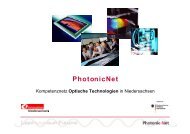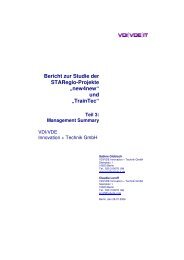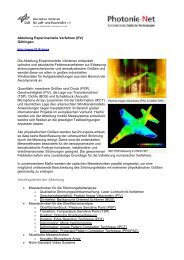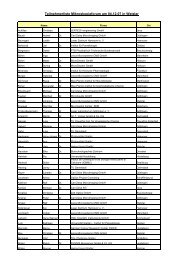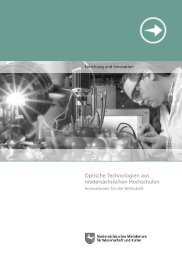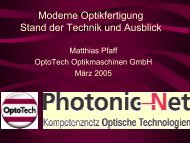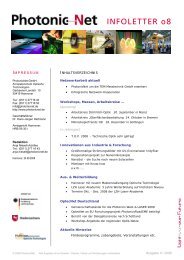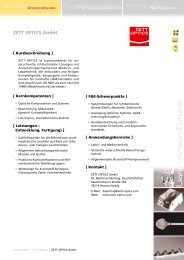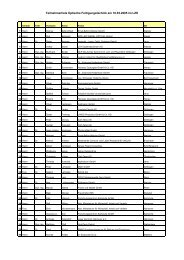Laser Micro Sintering - PhotonicNet GmbH
Laser Micro Sintering - PhotonicNet GmbH
Laser Micro Sintering - PhotonicNet GmbH
Create successful ePaper yourself
Turn your PDF publications into a flip-book with our unique Google optimized e-Paper software.
employment of q-switched pulses and the<br />
strategy of setting the pulses during selective<br />
sintering. Until then, pulsed laser sintering<br />
had been conducted mostly on an experimental<br />
level [3].<br />
Meanwhile the technique has been applied<br />
for the generation of manifold functional<br />
metal micro parts and has gained international<br />
advertence and acknowledgement.<br />
The ideas and applications are registered as<br />
patents and utility models. The technique<br />
and the equipment is marketed under the<br />
brand name microSINTERING by 3D-<strong>Micro</strong>mac<br />
AG, Chemnitz, Germany.<br />
<strong>Laser</strong> micro sintering – equipment<br />
and process principles<br />
Sinter chamber and powder coating<br />
device<br />
In selective laser sintering the powder material<br />
is alternately coated and sintered by<br />
a laser beam scanning the cross section of<br />
the expected sinter part. The early set up -<br />
consisting already of a hermetically closed<br />
sinter chamber and a special rake has been<br />
upgraded to higher efficiency and industrial<br />
applicability ("chamber type 2"). It is attached<br />
to a turbo molecular vacuum pump<br />
and has gate valves for various process gases.<br />
The laser radiation enters via a quartz glass<br />
window integrated into the lid.<br />
Two or more rakes sweep the powder materials<br />
in a circular motion onto the sample<br />
piston (sinter platform). This technique allows<br />
vertical gradients of material blends or<br />
of grain sizes in the sinter part.<br />
THE INSTITUTE<br />
<strong>Laser</strong>institut Mittelsachsen e.V.<br />
Mittweida, Germany<br />
<strong>Laser</strong>institut Mittelsachsen e.V. at Hochschule<br />
Mittweida is one of the leading institutions<br />
in the area of laser micro structuring.<br />
In its laboratories the respective<br />
technologies are investigated and developed<br />
since more than 30 years. Its up-todate<br />
equipment contains among others<br />
five micro sinter set-ups, numerous excimer<br />
lasers, two fs-lasers, and a VUV-laser.<br />
Further activities are PLD-techniques,<br />
laser macro processing, development of<br />
laser components, and laser measuring<br />
techniques.<br />
© 2007 WILEY-VCH Verlag <strong>GmbH</strong> & Co. KGaA, Weinheim<br />
Deviant from conventional devices, the<br />
blades of the rakes are metal cylinders; they<br />
also serve as intermediate powder reservoirs<br />
(Fig. 1). The pistons are tight for powders<br />
and liquids, allowing processing of slurries.<br />
The chamber can be evacuated down to<br />
pressures of 10 –3 Pa. Charging or flushing<br />
with process gases is possible and makes the<br />
device applicable for the combination of sintering<br />
with laser CVD.<br />
The process of laser micro sintering<br />
The early source of the laser pulses was a Qswitched<br />
Nd:YAG – laser (λ = 1064 nm) in<br />
TEM 00 mode [1], lately multimode pulses<br />
and other lasers with various wavelengths<br />
are used. A beam scanner with a scan field<br />
of 25 × 25 mm 2 steers the pulses over the<br />
corresponding micro body cross section<br />
(Fig. 2).<br />
The density and intensity of the pulses are<br />
adjusted during the process according to<br />
the requirements of the micro body's aspired<br />
properties, the geometry of the cross<br />
FIGURE 1: Ring blade serves as rake and<br />
powder storage.<br />
FIGURE 2: <strong>Laser</strong> micro sintering with separately<br />
set pulses.<br />
LASER MICRO MACHINING<br />
section and the material. This is achieved by<br />
application of the proprietary software IVS<br />
STL Converter (Version 1.0). It controls the<br />
actual sinter process. STL – data can be processed<br />
with a high resolution on a micrometer<br />
scale. Especially curves are executed at<br />
fast rates with high precision. Outline and<br />
filling parameters can be adjusted arbitrarily.<br />
Another - home-developed - program allows<br />
flexible control of the raking routine. Automatic<br />
performance of a complex SLS process<br />
including the generation of structural<br />
or density gradients is supported.<br />
The mechanistic model of metal laser<br />
micro sintering<br />
With single component powders the texture<br />
of the resulting solid area is not a closed coating<br />
of metal, but is more a network of craters<br />
or wedges that root about 5-10 µm below<br />
the mean surface level with crests above between<br />
1 and 3 µm. Densities between 40%<br />
and 75% arise from those materials. Blends,<br />
especially those consisting of a refractory<br />
and a lower melting metal, yield densities<br />
of 90 % and above [1]. The mechanism of<br />
pulsed sintering is believed to be a synergism<br />
of both melting and boiling [4]: The<br />
recoil the molten and solid powder material<br />
receives from the occurring plasma and the<br />
erupting material creates vertical interconnections<br />
between the sintered layers and the<br />
material being processed. With each pulse,<br />
the new material is attached mainly to or<br />
into the already sintered body below. Horizontal<br />
cross linking takes place only in the<br />
last stage of the sintering of each layer. This is<br />
the cause for the high resolution and the noticeable<br />
lack of thermally induced stresses.<br />
SEM views in Figs. 3 show the pulsing effects.<br />
High intensity pulses result in a higher degree<br />
of vertical cross linking and a higher rough-<br />
FIGURE 3a: High intensity pulses.<br />
www.laser-journal.de LTJ 27





